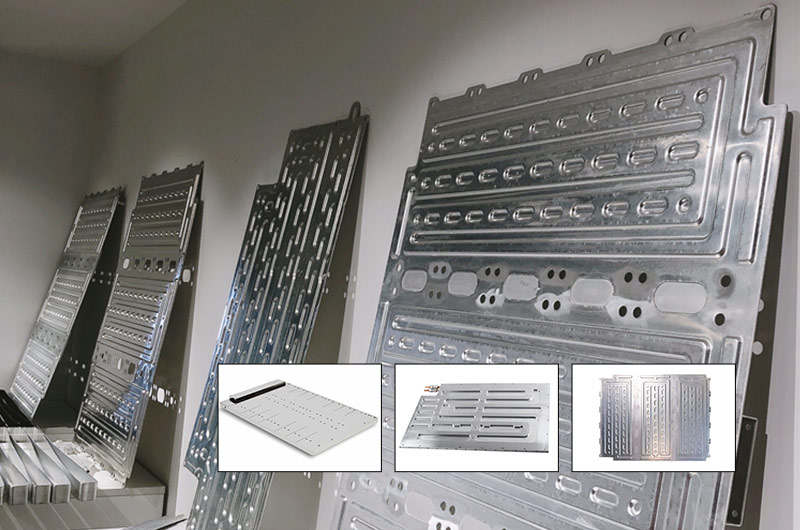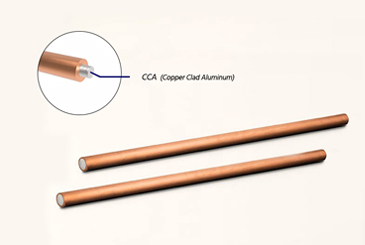Conventional new energy vehicle Power Battery Pack Aluminum Water Cooling Plate are usually welded with 3xxx series aluminum alloys. With the rapid development of new energy vehicles, the comprehensive performance requirements for battery water-cooled plates are getting higher and higher, and ordinary 3003 aluminum alloy Water Cooling Plate cannot meet the development needs due to strength limitations. Chalco has developed a brazed composite aluminum plate with high strength, high corrosion resistance, compact structure, and high heat dissipation efficiency to meet the liquid cooling plate with high performance requirements.
The alloy grades are as follows:
3003mod aluminum plate
3003/4045 brazing aluminum plate
3003/4343 brazing aluminum plate
3003mod/4343 brazing aluminum plate
3003/4004 brazing aluminum plate
Why choose Chalco?
Chalco Aluminum has passed the requirements of the automotive IATF16949 standard audited by BSI (British Standards Institution), providing quality compliance for continuously expanding the automotive product market and achieving high-quality development.
Chalco has a complete set of advanced new energy vehicle research and development, testing and analysis instruments, which guarantee the efficiency of new product research and development and accelerate the transformation of scientific and technological achievements. In addition, our R&D & innovation and verification capabilities can help enhance customers' competitiveness by saving time and cost in new product development and marketing.
Chalco Aluminum serves Tesla, Ford, Shanghai Automobile, Weilai Automobile, Beiqi New Energy, Changan Automobile and other famous new energy automobile manufacturers. Some models of automotive plate material certification.

Specifications of aluminum plate for power battery water cooling plate
| Alloy | 3003/3003mod/3003+4045/3003mod+4343 |
| Temper | O H12 H14 H16 H18 H22 H24 H26 H28 etc. |
| Thickness | 0.5mm-300mm |
| Width | 500-2650mm |
| Length | 500-12000mm |
| Thickness | 1mm-50mm |
| Sheet plate stock size | 1500mm×3000mm; 1220mm×2440mm |
Chemical composition of aluminum plate for power battery water cooling plate
| Alloy | 3003 | 4343 | 4045 |
| Si | 0.6 | 6.8-8.2 | 9.0-11.0 |
| Fe | 0.7 | 0.8 | 0.8 |
| Cu | 0.05-0.20 | 0.25 | 0.3 |
| Mn | 1.0-1.5 | 0.1 | 0.05 |
| Mg | - | - | 0.05 |
| Cr | - | - | - |
| Ni | - | - | - |
| Zn | 0.1 | 0.2 | 0.1 |
| Ti | - | - | 0.2 |
| Al | Remainder | ||
Mechanical properties of aluminum plate for power battery water cooling plate
| Material | Condition | Tensile Strength (ksi min) | Yield Strength (ksi min) | Elongation % in 2" 0.064 Sheet |
| Alloy 3003-0 Sheet 0.064" thick | 3003-0 | 14-19 | 5 | 25 |
| Alloy 3003-H12 Sheet 0.064" thick | 3003-H12 | 17-23 | 12 | 6 |
| Alloy 3003-H14 Sheet 0.064" thick | 3003-H14 | 20-26 | 17 | 5 |
| 3003-H16 Sheet 0.064" thick | 3003-H16 | 24-30 | 21 | 4 |
| 3003-Sheet 0.064" thick | 3003-H18 | 27 min | 24 | 4 |
Production process of aluminum plate for power battery water cooling plate
The Liquid Cold Plate process mainly includes raw material stamping-cleaning-flux coating-riveting-brazing-testing-glue sealing and other main processes. The general liquid-cooled plate production technology includes buried pipe process, profile + welding, machining + welding, die-casting + Welding.
Common structures of power battery water-cooled plates
A liquid cooling plate introduces cooling liquid into a cold plate with a cavity, which circulates and flows through the internal cavity. Through the heat conduction of the cold plate material, it cools the heat source in contact with the cold plate. The internal structure of the liquid cooled plate is a cavity structure. For areas with concentrated heat sources, in order to improve heat dissipation performance, a spoiler fin structure needs to be added to the cavity to improve performance. The purpose is to increase the flow resistance in this area by increasing the fin structure, thereby reducing the flow velocity in this area and improving the heat exchange efficiency between the fluid and the heat source.
The liquid cooled plate is mainly divided into three parts before welding: bottom plate, internal fin structure, and cover plate. After various welding processes, the product is welded into one body, and then the surface is processed into the required structure to form the final product.
Commonly used turbulence structures include:
- Aluminum plate fins
- Processing column structure
- Shovel fins

Welding process of water-cooled plates for power batteries
The commonly used welding processes for aluminum materials include argon arc welding, resistance welding, laser welding, vacuum brazing welding, friction stir welding, etc. For liquid cooled plate products, the welding area is relatively large and there is a high requirement for the cleanliness of the internal welding flow channel. Vacuum brazing and friction stir welding are mainly used.
Vacuum brazing is another commonly used welding method for aluminum welding. It is a welding method that uses brazing material lower than the melting point of the weldment and simultaneously heats the weldment to the melting temperature of the brazing material, and then fills the gap of the solid workpiece with liquid brazing material to connect the weldment. Especially suitable for thin plate welding between large contact surfaces, and can use the fin structure inside the flow channel to weld the bottom plate and cover plate into one
This enhances the stiffness of the entire liquid cooled plate and enhances its ability to resist deformation.
Features of aluminum plate for power battery water cooling plate
The power battery Liquid Cooled Baseplate is an important part of the battery system and is used to control the temperature of the battery. Using 3003 or 3003+4343 aluminum alloy to make Liquid Cooling Plate has the following advantages:
Good thermal conductivity: aluminum alloy has high thermal conductivity, which can quickly transfer the heat generated inside the battery to the surface of the Aluminum Water Cooling Plate, speed up the heat dissipation and improve the heat dissipation efficiency.
Lightweight: the density of aluminum alloy is low, and the use of aluminum alloy to make the Battery Water Cooling Plate can reduce the weight of the battery system and improve the energy efficiency of the whole vehicle.
Corrosion resistance: 3003/4343 liquid cooling aluminum plate has higher corrosion resistance and can maintain a long service life in harsh working environments.
Good weldability: 3003mod/4343 brazed Water Cooling Plate has good welding performance, and can be effectively welded with other components to improve the overall performance and reliability of the Aluminum Water Cooling Plate and battery system.

Application of aluminum plate for power battery water cooling plate
3003 aluminum water cooling plate
3003 aluminum alloy has good formability and corrosion resistance, and is suitable for manufacturing Liquid Cooling Plate with lower general requirements. It is often used in battery systems with small power such as small electric vehicles and hybrid vehicles.
3003MOD aluminum water cooling plate
3003MOD aluminum alloy is an improved material of 3003 alloy, which has better strength and toughness, and is suitable for Electric Vehicles Power Battery Water Cold Plate applications with higher requirements. It is often used in battery systems with high power such as medium and large electric vehicles and pure electric vehicles.
3003/4045 3003MOD/4343 brazed composite water cooling plate
3003/4045 3003MOD/4343 Brazed aluminum Plate is also a composite material, which is composed of 3003 3003MOD aluminum alloy substrate and 4045 4343 aluminum-silicon alloy welding layer. It has increased corrosion resistance and weldability for demanding Power Battery Pack Aluminum Water Cooling Plate applications. It is often used in battery systems with high power such as large electric vehicles and pure electric vehicles.















